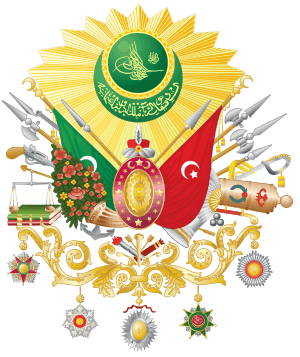Dürrünev Kadın
Dürrünev Kadın (Ottoman Turkish: درنو قادین; born Princess Melek Dziapş-lpa; 15 March 1835 – 7 December 1895), meaning "the new pearl",[1] was the first wife and chief consort of Sultan Abdulaziz of the Ottoman Empire.[2]
| Dürrünev Kadın | |||||
|---|---|---|---|---|---|
| Born | Princess Melek Dziapş-İpa 15 March 1835 Batumi, Georgia | ||||
| Died | 7 December 1895 (aged 60) Feriye Palace, Istanbul, Ottoman Empire | ||||
| Burial | |||||
| Spouse | |||||
| Issue | Şehzade Yusuf Izzeddin Saliha Sultan | ||||
| |||||
| House | Dziapş-İpa (by birth) Ottoman (by marriage) | ||||
| Father | Mahmud Dziapş-lpa | ||||
| Mother | Halime Çikotua | ||||
| Religion | Sunni Islam | ||||
Early life
Dürrünev Kadın was born on 15 March 1835[3] in Batumi, Georgia. Born as Melek Dziapş-lpa, she was a member of the Abkhazian Dziapş-lpa family. Her father was Prince Mahmud Bey Dziapş-lpa,[4] and her mother was Princess Halime Hanım Çikotua, an Abkhazian. She had two younger sisters, Princess Ayşe Kemalifer Hanım (1838 – 1901),[5] and Princess Aliye Hanım.[6] She was also the maternal aunt of Nazperver Kadın, fourth wife of Sultan Mehmed V.[7]
She had been brought to Istanbul as a young child, where her father entrusted her to the imperial harem together with her sister Ayşe. The two of them were then placed in the service of Sultan Abdulmejid I's first wife Servetseza Kadın, where her name according to the custom of the Ottoman court was changed to Dürrünev.[4][6]
Dürrünev had an avocation for painting and playing piano. She had also learned French.[6]
Marriage
One day, when Abdulaziz was in his twenties, he visited his sister-in-law Servetseza Kadın. Here he saw Dürrünev, then twenty one years old, and fell in love with her. He asked his sister-in-law to give him Dürrünev in marriage, but she flatly refused. However, after the prince's pleading to Servetseza, she acceded to her brother-in-law's demand. The marriage took place on 20 May 1856 in the Dolmabahçe Palace.[5][6]
Dürrünev gave birth to the couple's first child, a son, Şehzade Yusuf Izzeddin on 29 September 1857.[8] After Abdulaziz's accession to the throne on 25 June 1861,[9] Dürrünev was installed the principal consort with the title of "Senior Consort".[10] On 11 July 1862, she gave birth to the couple's second child, a daughter, Saliha Sultan.[11]
In October 1868,[12] Dürrünev met with Empress Eugénie de Montijo of France, when the latter paid a visit to Istanbul.[13] In 1869, she met with the Princess of Wales Alexandra of Denmark, when the latter visited Istanbul with her husband Prince of Wales Edward (future Edward VII).[14]
Abdulaziz was deposed by his ministers on 30 May 1876, his nephew Murad V became the Sultan.[15] He was transferred to Feriye Palace the next day.[16] Dürrünev, and other women of Abdulaziz's entourage didn't wanted to leave the Dolmabahçe Palace. So they were grabbed by hand and were send out to the Feriye Palace. In the process, they were searched from head to toe and everything of value was taken from them.[17] On 4 June 1876,[18] Abdulaziz died under mysterious circumstances.[19]
Death
Dürrünev Kadın died on 7 December 1895[10] at the Feriye Palace,[13] and was buried in the mausoleum of Sultan Mahmud II, located at Divan Yolu street, Istanbul.[20]
Issue
Dürrnev and Abdülaziz had two children:
- Şehzade Yusuf Izzeddin (Constantinople, Beşiktaş, Dolmabahçe Palace, 29 September 1857 – Constantinople, Çamlıça Palace, 1 February 1916), married six times and had issue.
- Saliha Sultan (Constantinople, Beşiktaş, Dolmabahçe Palace, 11 July 1862 – Cairo, Egypt, 1941, and buried there), married and had issue.
References
- A Gyre Thro' the Orient. Republican Book and Job Printing Office. 1869. p. 62.
- Milletlerarası Türk Halk Kültürü Kongresi (1997). Beşinci Milletlerarası Türk Halk Kültürü Kongresi. Kültür Bakanlığı. p. 10. ISBN 978-9-751-71757-3.
- Sakaoğlu 2008, p. 640.
- Açba 2004, p. 22.
- Açba 2004, p. 22-3.
- Açba 2007, p. 84.
- Açba 2007, p. 172.
- Brookes 2010, p. 291.
- Davison, Roderic H. (December 8, 2015). Reform in the Ottoman Empire, 1856-1876. Princeton University Press. p. 109. ISBN 978-1-400-87876-5.
- Uluçay 2011, p. 232.
- Uluçay 2011, p. 234.
- Freely, John (July 1, 2001). Inside the Seraglio: Private Lives of the Sultans in Istanbul. Penguin. p. 273.
- Açba 2007, p. 85.
- Cherry, Debrah; Halland, Janice (2006). Local/global: Women Artists in the Nineteenth Century. Ashgate Publishing, Ltd. p. 79. ISBN 978-0-754-63197-2.
- Zürcher, Erik J. (October 15, 2004). Turkey: A Modern History, Revised Edition. I.B.Tauris. p. 73. ISBN 978-1-850-43399-6.
- Shaw, Stanford J.; Shaw, Ezel Kural (1976). History of the Ottoman Empire and Modern Turkey: Volume 2, Reform, Revolution, and Republic: The Rise of Modern Turkey 1808-1975, Volume 11. Cambridge University Press. pp. 164. ISBN 978-0-521-29166-8.
- Brookes 2010, p. 40.
- Davison, Roderic H. (December 8, 2015). Reform in the Ottoman Empire, 1856-1876. Princeton University Press. p. 341. ISBN 978-1-400-87876-5.
- Brookes 2010, p. 43.
- Sakaoğlu 2008, p. 641.
Sources
- Uluçay, M. Çağatay (2011). Padişahların kadınları ve kızları. Ötüken. ISBN 978-9-754-37840-5.
- Açba, Harun (2007). Kadın efendiler: 1839-1924. Profil. ISBN 978-9-759-96109-1.
- Sakaoğlu, Necdet (2008). Bu Mülkün Kadın Sultanları: Vâlide Sultanlar, Hâtunlar, Hasekiler, Kandınefendiler, Sultanefendiler. Oğlak Yayıncılık. ISBN 978-6-051-71079-2.
- Açba, Leyla (2004). Bir Çerkes prensesinin harem hatıraları. L & M. ISBN 978-9-756-49131-7.
- The Concubine, the Princess, and the Teacher: Voices from the Ottoman Harem. University of Texas Press. 2010. ISBN 978-0-292-78335-5.
